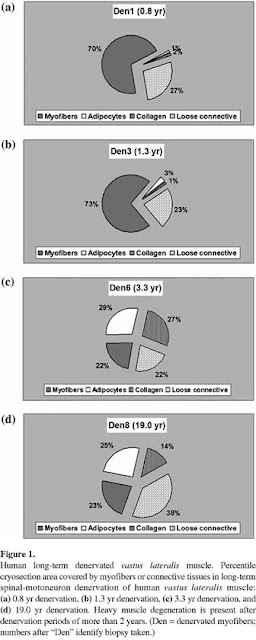What is denervated muscle?
Denervated muscle is muscle that receives no impulses from the PNS or CNS. This muscle does not move as transmissions cannot get to the muscle.
What happens to a denervated muscle?
A denervated muscle becomes weak and starts to waste away, this is known as atrophy. The outcome of an atrophied muscle is a decrease in muscle mass and the size of the muscle fiber. Myofibrils are seen to decrease and this is replaced with fat and connective tissues.
What are the best types of stimulation for denervated muscles?
The best type of pulses for denervated muscles is long duration pulses. Long stimulus duration pulses demonstrated to reduce the amount of fat and connective tissue in denervated muscle. This kind of pulse produces the longest possible current flow to stimulate muscles into titanic contractions. There are two types of long duration waveforms: triangular and rectangular.
Triangular waveform is preferred over rectangular because triangular waveforms bypass the nerve and goes directly to stimulate the muscle. This prevents the muscle from accommodating allowing for full excitability and contraction of the muscle.
What are the specific parameters and time length?
Unfortunately there are no set parameters for long stimulus duration pulses. However, as previous mentioned rectangular waveforms are usually 1-600ms and separated by pulse interval of 1ms-several seconds where as, triangular waveforms are 300-1000ms and separated by pulse intervals of ½ to several seconds. Patients with chronic denervation must keep with electrical stimulation, as once they stop the muscle will atrophy again! Therefore, patients must spend the time everyday applying estim.
So now, is estim worth it?
The answer to this question is not quite clear cut. Although estim may not be able to reverse all consequences of long term denervation, there is no denying the positive effects estim has on denervated muscle. There has been shown an increase in the excitability, in the mass and in myofibril count of denervated muscles. In patients this can improve cosmetic appearance, provide better cushioning to reduce pressure sores and thus may decrease the time spent in hospital (Salmons et al, 2005). While these effects themselves maybe worthwhile, the protocol the patient must endure to see these effects is very time consuming. In one study we found by Valencic et al (1986), improvement in denervated muscles was shown by stimulating the muscle 5 days a week for 20 mins, two times a day for three weeks. This may not seem too bad but remember for those patients with chronic stimulation, they must keep applying estim or else atrophy will occur again. More recently, Kern et al (2002), has stated that each muscle group needs to be stimulated for 15-20 mins once or twice a day to induce changes in the muscle, thus if trying to excite more than one muscle group, the patient could be applying estim for 1.5 to 2 hours.
While the benefits of estim are present, it widely depends on the patients goals and motivation on whether or not to take up estim. For now, estim on permanently denervated muscles would just be for the cosmetic aspects, however with advancing research in medicine, it is possible a reversal of denervation may come to pass.
That is all for Team North America, it has been fun but alas we must say goodbye!
Team North America signing off—
-Megs and Brooke-
References
Kern, H., Hofer, C., Mödlin, M., Forstner, C., Raschka-Högler, D., Mayr, W., & Stöhr, H. (2002) Denervated muscles in humans: limitations and problems of currently used functional electrical stimulation training protocols. Artif Organs, 26(3):216-8.
Salmons, S., Ashley, Z., Sutherland, H., Russold, M.F., Li, F., & Jarvis, J.C. (2005). Functional electrical stimulation of denervated muscles: basic issues. Artif Organs, 3:199-202.
Valencic, V., Vodovnik, L., Tefancic, M, & Jelnikar, J. (1986). Improved motor response due to chronic electrical stimulation of denervated tibialis anterior muscle in humans. Muscle Nerve, 9:612-617.

